Intermarkets' Privacy Policy
Donate to Ace of Spades HQ!
aceofspadeshq at gee mail.com
Buck:
buck.throckmorton at protonmail.com
CBD:
cbd at cutjibnewsletter.com
joe mannix:
mannix2024 at proton.me
MisHum:
petmorons at gee mail.com
J.J. Sefton:
sefton at cutjibnewsletter.com
America Is Too Stoned Already: We Don't Need More Marijuana Availability
Sunday Morning Book Thread - 12-28-2025 ["Perfessor" Squirrel]
Daily Tech News 28 December 2025
Saturday Night "Club ONT" December 27, 2025 [The 3 Ds]
Saturday Evening Movie Thread [moviegique]: Klaus (2019)
Hobby Thread - December 27, 2025 [TRex]
Ace of Spades Pet Thread, December 27
Gardening, Home and Nature Thread, Dec. 27
Thread before the Gardening Thread, December 27 - Irony
Jim Sunk New Dawn 2025
Jewells45 2025
Bandersnatch 2024
GnuBreed 2024
Captain Hate 2023
moon_over_vermont 2023
westminsterdogshow 2023
Ann Wilson(Empire1) 2022
Dave In Texas 2022
Jesse in D.C. 2022
OregonMuse 2022
redc1c4 2021
Tami 2021
Chavez the Hugo 2020
Ibguy 2020
Rickl 2019
Joffen 2014
maildrop62 at proton dot me
TBD
Spaced-Out Challenge: Messier Marathon Mega-Thread (Part 2)
[We Politely Request That All Off-Topic or Political Comments Be Directed to the Open Thread down page, Which Will Serve Officially as the Current "Active Conversation" Thread for All Discussions Not Related To This Topic. Enjoy!]
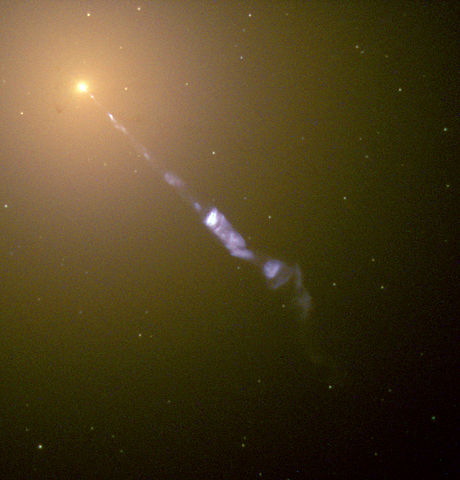
Welcome again to the Spaced-Out Challenge! Whether you have a question about equipment, a new astronomical discovery you want to expand on, or just want to kick back and enjoy the cosmos above, come one come all on our weekly astronomical journey.
This week, we continue our beginner's guide to the Messier Marathon, the best nights for which are coming on Saturday, March 29th, and Sunday, March 30th. We stopped our hunt of Charles Messier's “nuisance nebulae” around Midnight, leaving our galaxy for island universes beyond. Now, it's time to go straight into the heart of the Virgo Galaxy Cluster. Tiny smudges of light, some fuzzy, some with faint arms, but all right before your own eyes: a view at the grandest of scales we can see. Come, let me show you.
Part One of our Messier Guide can be found here.
Overview Map pops out here: View image
At Midnight, the Virgo Galaxy cluster is riding high, giving you an excellent opportunity to pick off a massive number of Messier objects, and to enjoy some of the finest galaxies in that or any catalog. The brightest stars- Arcturus, Spica, and Regulus- are joined by a brightening Mars, so use these as your anchor stars, and align your map above accordingly.
Messier 53: A(nother) Globular in Coma Berenices.
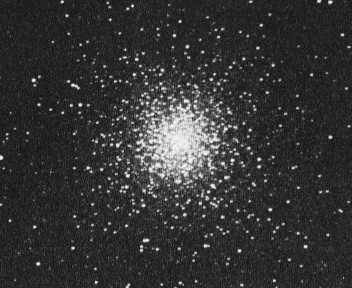
Coma Berenices is a faint constellation susceptible to light pollution, but from your dark sky location, its magnificent star cluster and faint main stars are plainly visible. Looking to your south, and about midway up from your horizon, it forms an upside-down L above Virgo. Aim your binoculars at the southernmost main star Ithe brightest in the small constellation), and you'll notice a small, fuzzy patch of light: the globular cluster M53, an ancient cluster of over 100,000 stars about 65,000 light years distant.
The Black Eye Galaxy (Messier 64)
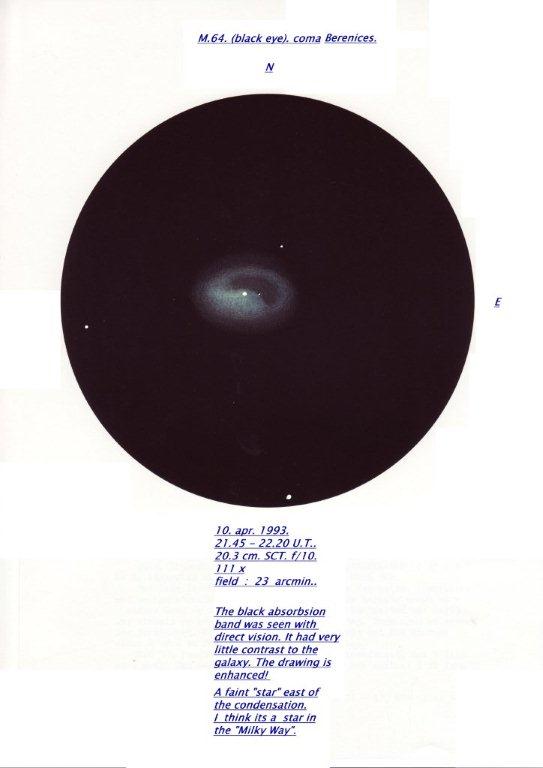
About a binocular's FOV north and west of Alpha Coma Berenices (the star you used to find M53) lies the striking galaxy M64. The Black Eye gets its name from the striking dark band of absorbing dust in front of the galaxy's bright nucleus, visible in most telescopes from a dark site.
The Suburbs of the Virgo Cluster
Beneath downtown Virgo are two contrasting galaxies in the Messier catalog.
Messier 61
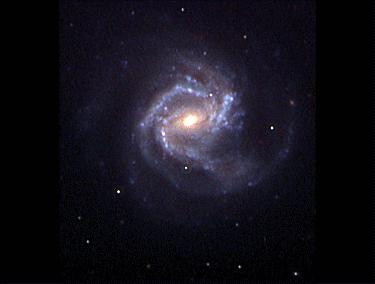
A beautiful small spiral, M61 was initially mistaken for a comet by Charles Messier, but was cataloged as a nebulae after it hadn't moved over several observations. It has been relatively active: six supernova have been observed and cataloged since frequent observations began.
Messier 49
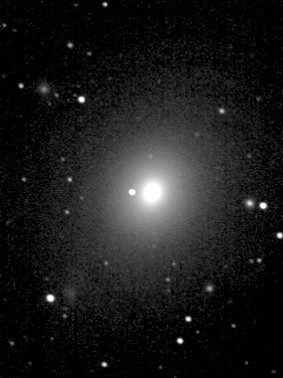
One of the brightest galaxies in the cluster, this giant elliptical galaxy was erronously thought to be more massive than M87 (see below). While it can't claim that brag, it is still a monster, stretching a full 60,000 light years wider than our own Milky Way. This is one of the easiest galaxies to see because of it's brightness. Averted viewing can help bring out the faint fuzziness enveloping the very bright core.
Messier 85
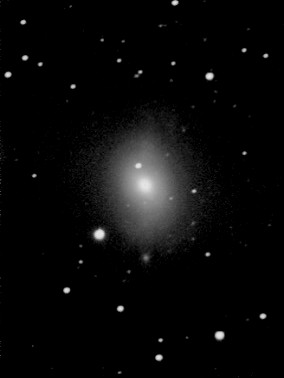
Another reasonably bright one in the cluster, M85 is a lenticular galaxy populated by older yellow stars. A faint hazy blob in small telescopes, don't let it's appearance fool you: this galaxy is at least 25% larger than our home.
Downtown Virgo
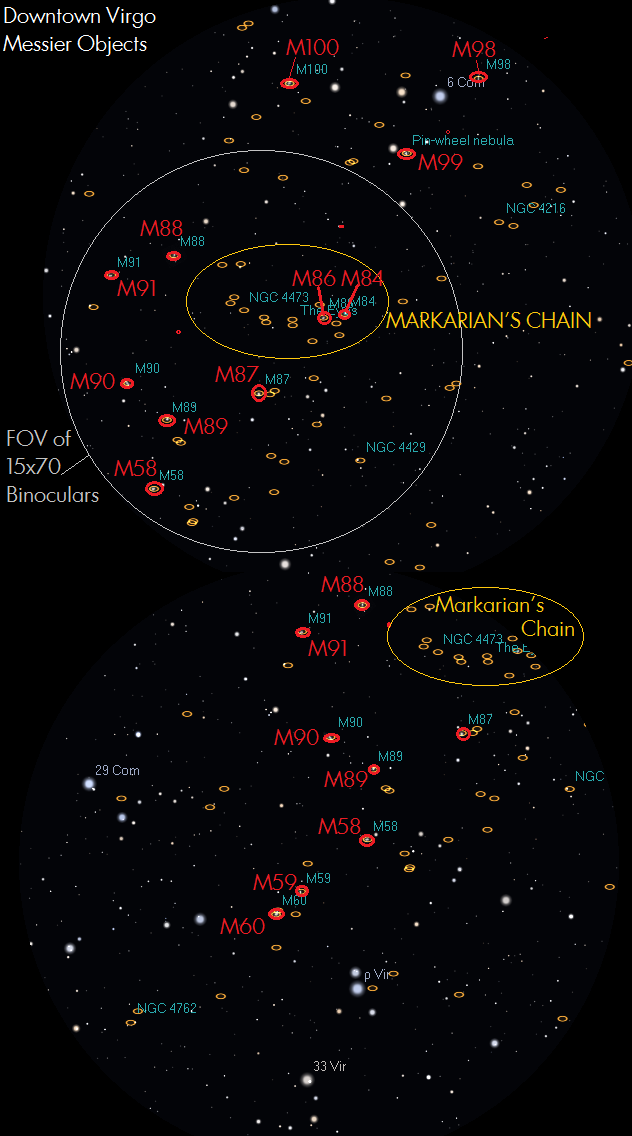
Messier 100
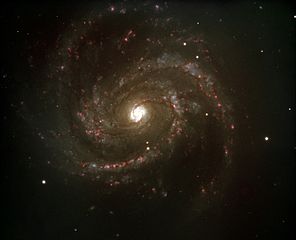
One of the most beautiful spirals in the Messier catalog, it is another bright member of the Virgo Group. Lord Rosse mentioned it as one of his 14 spiral nebulae in 1850. It isn't hard to see how it earned the designation of being a "grand design" spiral. From a dark site, amateurs can see the central regions of this galaxy as a faint elliptical patch in small telescopes or good binoculars. Under very good observing conditions, suggestions of the inner spiral arms can be glimpsed in 4" telescopes or larger, and more of the "grand design" can be teased out with an 8" dobsonian.
Messier 98
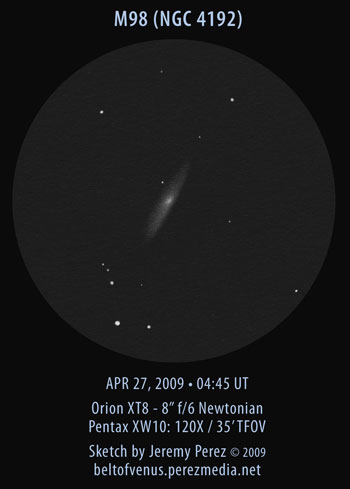
Fainter and thus a bit tougher to see, this edge-on spiral is best found by hopping from star 6 Com. It's dust-filed disk obscures most of the nucleus.
Messier 99
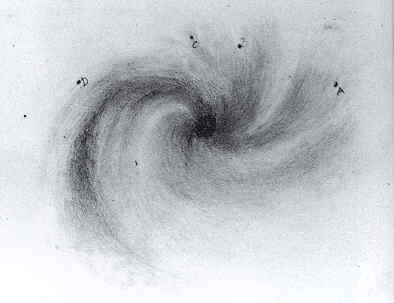
Another nearly face-on spiral galaxy, M99 boasts the record for the highest receding velocity speed, moving through the cosmos at over 1200 kilometers a second. Some star formation regions can be teased out with larger dobsonians.
Messier 84, Messier 86 & Markarian's Chain
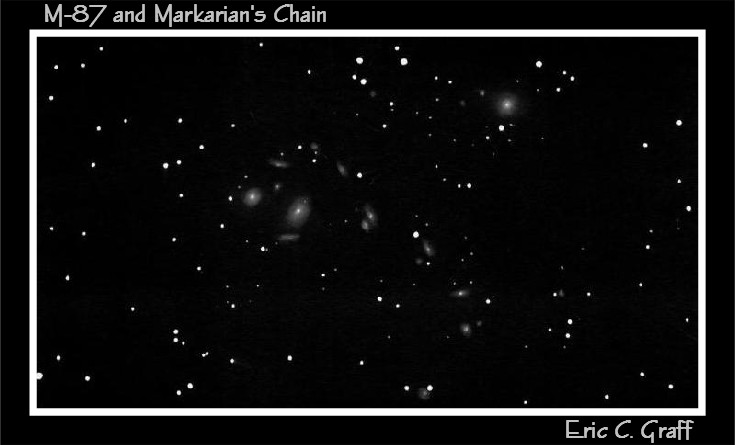
Markarian's Chain is a “string” of galaxies discovered by it's namesake to have the same proper motion through the cluster, and is anchored on one end by M84 and M86. It's fainter members really pop out in scopes of at least 4” of aperture. Lying right smack between Vindemiatrix in Virgo and Denebola in Leo, I've used the chain as a starting point for observing all of the Messiers in this section. Take your time and see how many you can actually spot beyond the obviously bright Messiers. Can you see the “eyes” ?
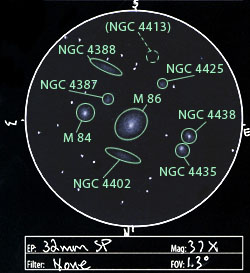
Messier 87
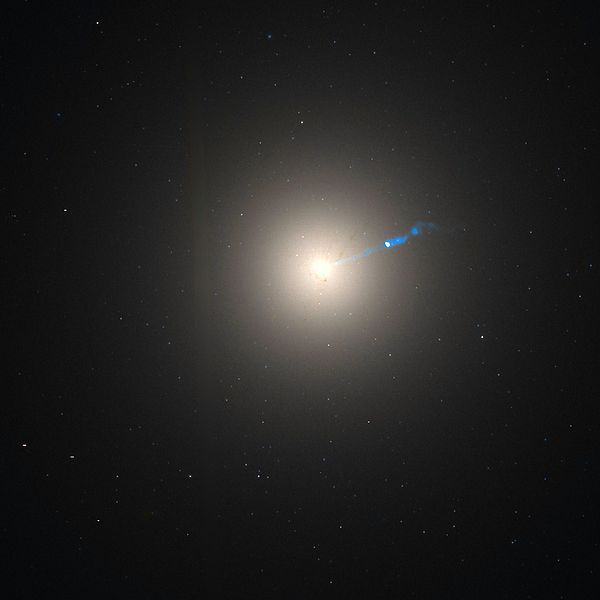
Messier 87 lies at the heart of the cluster, as well it should: this monstrously massive elliptical galaxy is one of the largest known. It's supermassive black hole spits out a relativistic jet of plasma that poses a challenge all it's own for owners of very large dobsonian telescopes- many have claimed visual observations of it!
The trio of Messier 84, 86, and 87 are bright enough to spot with even crappy binoculars, so long as you are observing from a dark sky. Amateur Jeremy Perez shares his sketch and thoughts on these three:
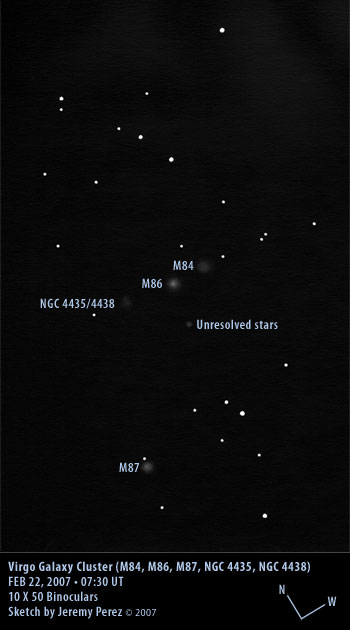
The broad stretches of the Virgo Cluster of Galaxies are a real treat telescopically, but what does it look like through binoculars? And not just any old astronomy-grade binoculars, but really crummy ones? Well, I and my twenty dollar laughing-stock 10x50 binoculars are happy to say that you can indeed enjoy these galactic poofs on a bino-budget. But you'll still need a dark sky on your side.
Drawing a bead--and a crick'd neck--on the heart of the cluster slowly revealed two soft patches that are the bright galaxies, M84 and M86. M86 was the brighter of the two, and appeared more strongly concentrated at its core. It was also hard to miss the soft glow of M87 as it hugged a nearby eighth magnitude star. With some patience, a much more elusive smear appeared east of M86 from the combined light of NGC 4435 and 4438. I also noted a soft glow due south of M86 that turned out to be the unresolved glow of a grouping of stars in the area.
So, what can I say? If your current choice of binoculars gives you just a wee touch of shame, but you've got a dark sky to play with, go ahead and grab those dogs, and a pack of ice for your neck, and give some Virgo galaxies a shot. You may be pleasantly surprised.
Messier 88
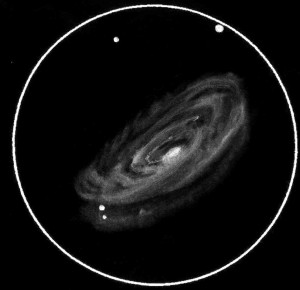
A stunning spiral galaxy for small telescopes, as the sketch above shows, the classic swirling shape is unmistakable. If many of the other galaxies seem underwhelming in your smaller instrument, aim for the one that never disappoints.
Messier 91
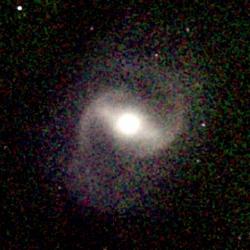
From stunning and bright we switch to a far more difficult object for the amateurs, but rewarding to cross off your list, M91, one of the fainter galaxies in the cluster and one of the faintest of all the Messier objects.
Messier 90
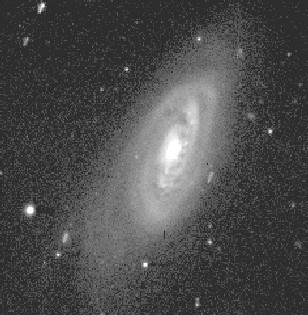
One of the larger spiral galaxies in the cluster, M90's tightly-wounded, bright arms appear to be devoid of star formation.
Messier 89
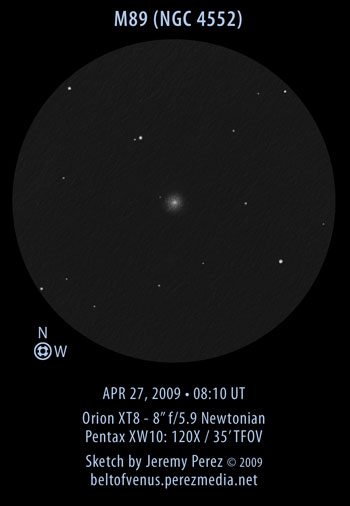
Arguably one of the most circular elliptical galaxies easily visible by amateurs, some compare it's appearance to smaller globular clusters, but don't let it's compactness fool you: it's at least a billion times more massive than our most impressive globular.
Messier 58
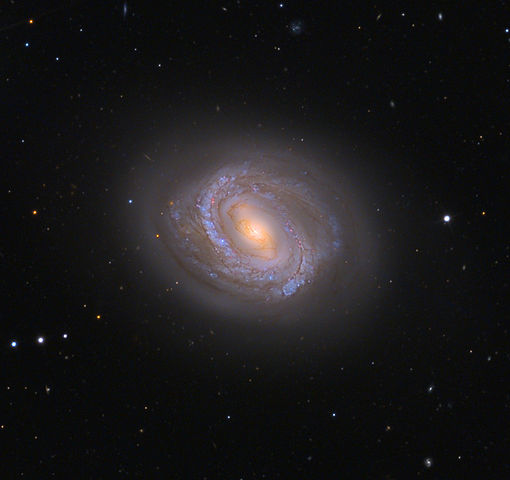
A barred spiral, small telescopes show only its bright nucleus, giving it an elliptical appearance. Under good conditions, 4-inch scopes or better reveal an oddly shaped halo enveloping the core. Hints of the bar structure begin with telescopes of about 8" of aperture.
Messier 59 & 60
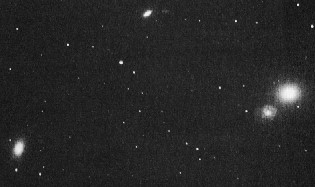
Slightly flattened and less massive than M49 or M87, Messier 59 is still an impressive elliptical galaxy with more stars than our own. It's close proximity to M60 means both can pop into view at very low power.
A monster lies within the bright, giant elliptical galaxy M60: HST observations have revealed an object with a mass 2 billion times that of our sun, likely a supermassive black hole that could eat the Milky Way's lunch several times over.
Don Machholz compiled an excellent star/galaxy hopping sequence for all of these galaxies for his Messier Marathon Observer's Guide, if the map seems too condensed to plan your own hop. Remember to work at low power in your telescope, or mount your binoculars for additional stability, and dive in:
From Denebola (Beta Leonis), go 0.3 deg N and 6.8 deg following (E) to star 6 Comae. From here go 0.5 deg preceding (W) to find M98.
From M98 go 0.5 deg S, 1.2 deg following (E) to M99. [It is near a mag 6 star]
From M99 travel 1.0 deg following (E), 1.4 deg N to M100. [2 mag-6 stars point to it from 6 Com]
From M100 go 0.6 deg following (E), 2.4 deg N to M85 and faint NGC 4394 (10' E)
From M85 sweep 5.3 deg S to find M84 and M86 in one field, together with a number of fainter NGC galaxies including NGC 4388; 15' NE of M86 is the interacting pair NGC 4435/4438.
From M86 go 0.6 deg S, 1.1 deg following (E) to M87.
From M87 go 0.2 deg N, 1.2 deg following (E) to M89.
M90 is 0.3 deg following (E), 0.7 deg N of M89.
From M90 travel 1.2 deg preceding (W), 1.2 deg N to M88.
M91 is situated 0.1 deg N, 0.8 deg following (E) of M88 - same low-power rich-field.
From M91 sweep 0.6 deg following (E), 2.7 deg S to M58 [situated east of and near a mag 6 star]
From M58 go 0.2 deg S, 1.1 deg following (E) to M59. In the same field should be M60 (0.1 deg S, 0.4 deg E) with its fainter companion NGC 4647.
From M60 travel 3.4 deg preceding (W), 3.5 deg S to find M49; from M49 go 2.0 deg preceding (W), 3.5 deg S to M61.
In small instruments, these may appear as lumpy patches of light. But thanks to our understanding of the universe, we now comprehend (or try to) that each is much like our home galaxy, filled with black holes, comets, pulsars, gas clouds, suns, moons, and planets. The next time you walk on a beach, consider the sand beneath your feet. Now imagine our sun as a grain of sand. At that scale, our Milky Way would be a sand castle five stories high (if all of the suns were packed together, which we know is certainly not the case). As impressive as our own backyard may be, there are more stars in the galaxies beyond than there are grains of sand on Earth. Our home is a speck too small to even imagine, in a star field too smushed to resolve, in a galaxy barely discernible for an intelligent being on the other side of the universe.
If you've followed this guide successfully so far, congratulations: you've knocked out over a third of the Messier objects, with the Spring and Summer targets rising up in the last part of our guide.
Remember, tonight is also the relaunch of COSMOS (this version featuring Neil deGrasse Tyson), which will air at 9pm on FOX and all non-news FOX channels (FX, FXX, etc), the latest trailer of which you can see here:
The full Beginner's Buyer's Guide, our Comet Guide (featuring additional grab-and-go telescopes), and any other edition you're looking for can be found in the master index of all Spaced-Out Challenge threads here, but of course you can always inquire about binoculars, telescopes, and all the rest in the comments. As always, if you have astrophotography, product recommendations, or astronomy news you'd like to see on a future Spaced-Out Challenge, email me at theoneandonlyfinn (at) gmail.com, or tweet me @conartcritic.
If you have any more questions about your new optics, feel free to ask below. Until next time, clear skies to you, and keep looking up!
On March 23rd, we finish our Messier Marathon Guide. See you in a few Sundays!
[/i][/s][/b][/u]Oddbob: "[i]It seems we are waiting for a apology before we ..."
Its Go Time Donald : "WSJ: Dallas Is Booming—Except for Its Downto ..."
Another much-rumored stoner of stoners: "339 Not gonna read through 300+ comments. Has J ..."
BurtTC: "Do you really want him in irritated, perchance cra ..."
JQ: "Has Jack Straw chimed in yet? Posted by: davidt ..."
San Franpsycho: "The people I saw wandering aimlessly and dishevele ..."
Skip : "It seems we are waiting for a apology before we ca ..."
Franklin, one of the Fabulous Furry Freak Bros: "[i]I have no respect for potheads. Posted by: Dr. ..."
Orson: "333 Y'all know that CBD is probably making his Art ..."
davidt: "Not gonna read through 300+ comments. Has Jack ..."
Random Yeti on Mount Everest: "Looks like I picked the wrong thread to post a vid ..."
America Is Too Stoned Already: We Don't Need More Marijuana Availability
Sunday Morning Book Thread - 12-28-2025 ["Perfessor" Squirrel]
Daily Tech News 28 December 2025
Saturday Night "Club ONT" December 27, 2025 [The 3 Ds]
Saturday Evening Movie Thread [moviegique]: Klaus (2019)
Hobby Thread - December 27, 2025 [TRex]
Ace of Spades Pet Thread, December 27
Gardening, Home and Nature Thread, Dec. 27
Thread before the Gardening Thread, December 27 - Irony
Paul Anka Haiku Contest Announcement
Integrity SAT's: Entrance Exam for Paul Anka's Band
AllahPundit's Paul Anka 45's Collection
AnkaPundit: Paul Anka Takes Over the Site for a Weekend (Continues through to Monday's postings)
George Bush Slices Don Rumsfeld Like an F*ckin' Hammer
Democratic Forays into Erotica
New Shows On Gore's DNC/MTV Network
Nicknames for Potatoes, By People Who Really Hate Potatoes
Star Wars Euphemisms for Self-Abuse
Signs You're at an Iraqi "Wedding Party"
Signs Your Clown Has Gone Bad
Signs That You, Geroge Michael, Should Probably Just Give It Up
Signs of Hip-Hop Influence on John Kerry
NYT Headlines Spinning Bush's Jobs Boom
Things People Are More Likely to Say Than "Did You Hear What Al Franken Said Yesterday?"
Signs that Paul Krugman Has Lost His Frickin' Mind
All-Time Best NBA Players, According to Senator Robert Byrd
Other Bad Things About the Jews, According to the Koran
Signs That David Letterman Just Doesn't Care Anymore
Examples of Bob Kerrey's Insufferable Racial Jackassery
Signs Andy Rooney Is Going Senile
Other Judgments Dick Clarke Made About Condi Rice Based on Her Appearance
Collective Names for Groups of People
John Kerry's Other Vietnam Super-Pets
Cool Things About the XM8 Assault Rifle
Media-Approved Facts About the Democrat Spy
Changes to Make Christianity More "Inclusive"
Secret John Kerry Senatorial Accomplishments
John Edwards Campaign Excuses
John Kerry Pick-Up Lines
Changes Liberal Senator George Michell Will Make at Disney
Torments in Dog-Hell
The Ace of Spades HQ Sex-for-Money Skankathon
A D&D Guide to the Democratic Candidates
Margaret Cho: Just Not Funny
More Margaret Cho Abuse
Margaret Cho: Still Not Funny
Iraqi Prisoner Claims He Was Raped... By Woman
Wonkette Announces "Morning Zoo" Format
John Kerry's "Plan" Causes Surrender of Moqtada al-Sadr's Militia
World Muslim Leaders Apologize for Nick Berg's Beheading
Michael Moore Goes on Lunchtime Manhattan Death-Spree
Milestone: Oliver Willis Posts 400th "Fake News Article" Referencing Britney Spears
Liberal Economists Rue a "New Decade of Greed"
Artificial Insouciance: Maureen Dowd's Word Processor Revolts Against Her Numbing Imbecility
Intelligence Officials Eye Blogs for Tips
They Done Found Us Out, Cletus: Intrepid Internet Detective Figures Out Our Master Plan
Shock: Josh Marshall Almost Mentions Sarin Discovery in Iraq
Leather-Clad Biker Freaks Terrorize Australian Town
When Clinton Was President, Torture Was Cool
What Wonkette Means When She Explains What Tina Brown Means
Wonkette's Stand-Up Act
Wankette HQ Gay-Rumors Du Jour
Here's What's Bugging Me: Goose and Slider
My Own Micah Wright Style Confession of Dishonesty
Outraged "Conservatives" React to the FMA
An On-Line Impression of Dennis Miller Having Sex with a Kodiak Bear
The Story the Rightwing Media Refuses to Report!
Our Lunch with David "Glengarry Glen Ross" Mamet
The House of Love: Paul Krugman
A Michael Moore Mystery (TM)
The Dowd-O-Matic!
Liberal Consistency and Other Myths
Kepler's Laws of Liberal Media Bias
John Kerry-- The Splunge! Candidate
"Divisive" Politics & "Attacks on Patriotism" (very long)
The Donkey ("The Raven" parody)

